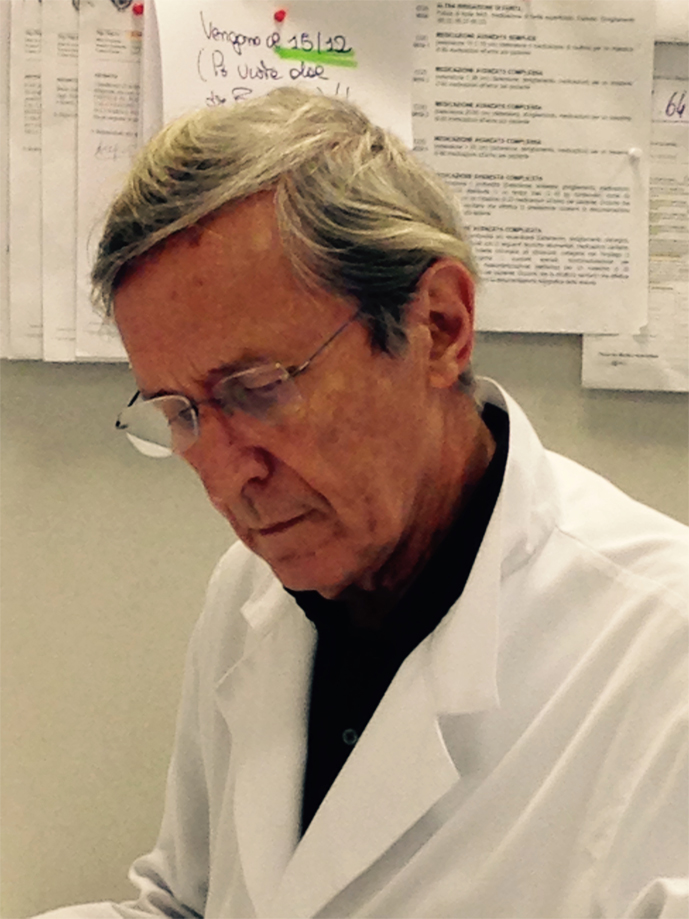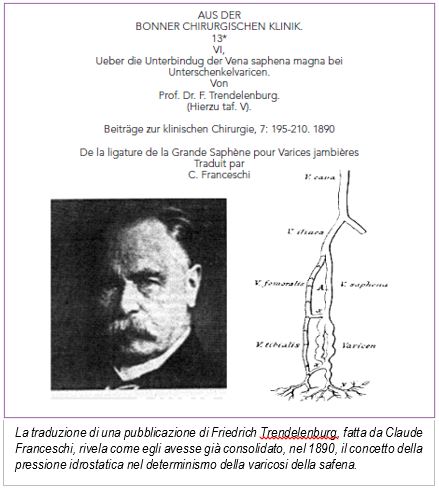Paper by Claude Franceschi
From the classical phlebology
to the era of color Doppler ultrasound investigation
 The modern era of non-invasive vascular investigation started in 1977 with the publication by Claude Franceschi of the first handbook of Doppler investigation. At the end of the 1960’s Franceschi started his work of decoding the sounds and tracks of a piece of equipment, at that time new and unknown, that by using the Doppler effect allowed, in theory, to draw information about the flow and the speed of blood in the vessel.
The modern era of non-invasive vascular investigation started in 1977 with the publication by Claude Franceschi of the first handbook of Doppler investigation. At the end of the 1960’s Franceschi started his work of decoding the sounds and tracks of a piece of equipment, at that time new and unknown, that by using the Doppler effect allowed, in theory, to draw information about the flow and the speed of blood in the vessel.The doppler effect was discovered by Cristian Andreas Doppler in 1845 by perform ing a famous experiment that analysed the sound produced by a few musicians situated on a train getting either nearer to or farther from the listener, and also measured the pitch increase of the approaching sound and the pitch decrease of the sound that moving away, a conclusion to which another researcher, the Frenchman Hippolyte Fizeau, came to only three years later.
 In practice, when using a probe that sends out and receives ultrasounds and applying such ultrasounds to a vessel that contains moving blood, the returning ultrasounds will have a different frequency than the original emission. Such a difference, proportional to the flow speed of the blood through the vessel and to the angle of incidence of the beam of ultrasounds on the directrix of the blood flow, falls within the range of frequencies that are audible to the human ear and through a device for Doppler investigation it is transformed, once it is amplified, into a sound, and the variations of speed (i.e. of frequency) generate a graphic curve.
In practice, when using a probe that sends out and receives ultrasounds and applying such ultrasounds to a vessel that contains moving blood, the returning ultrasounds will have a different frequency than the original emission. Such a difference, proportional to the flow speed of the blood through the vessel and to the angle of incidence of the beam of ultrasounds on the directrix of the blood flow, falls within the range of frequencies that are audible to the human ear and through a device for Doppler investigation it is transformed, once it is amplified, into a sound, and the variations of speed (i.e. of frequency) generate a graphic curve.Owed to doctor Franceschi’s work is the decoding of the sound and curves of the graphic, which have been transformed in haemodynamic conditions that allow diagnostics of haemodynamic status in an arterial or venous vessel: flow direction, acceleration, stenosis, obstruction, demodulation and turbulence are all haemodynamic conditions that had not been detectable at all or at least some not in a non-invasive way.
From that moment on this device has allowed non-invasive diagnostic assessment of outpatients.
Thanks to the experience acquired in the Doppler investigation, which had started in the district of the supra-aortic arterial vessel, it was possible to start the pioneering experience in the venous field too, out of which the present structure of the modern haemodynamic venous diagnostics originated.
During the continuation of the experience of vascular ultrasonographic investigation they realized the potential of the association of such an investigation with the ultrasound. Thanks to Franceschi’s studies the first book of vascular ultrasound investigation was published in 1986, which further accelerated the acquisition of new knowledge in the vascular field.
Going back to the haemodynamic venous investigation, it was under Jean Michel Cormier’s spur a vascular surgeon well known among specialists, that Franceschi started to study the venous flow in depth in order to search for the haemodynamic reasons for varicose illness in the lower limbs, all this leading to the elaboration of a therapeutic strategy that could treat varixes without removing saphenas, which are considered an endogenous heritage of vascular prostheses present in most patients that is useful for a potential bypass.
In this phase of his study Franceschi realized the importance of the hydrostatic pressure of the blood columns that rest on the venous periphery in causing venous dilatation and, above all, he made many new concepts available regarding physiology and physiopathology but I am particularly interested in the mechanism of hydrostatic fractionation of the column of the haematic pressure, the concept of valvulo-musclar pump, the fundamental concept of transmural pressure, the concept of residual pressure, and the concept and types of Shunts. He also introduced a terminology for haemodynamic anatomy to differentiate between venous nets (reseaux-nets: R1-R2-R3-R4), in order to make it homogenous for everybody, and the haemodynamic description of a net, which was the first great example of systematisation of the venous circulation.
 In 1988 Franceschi presented the therapeutic strategy called CHIVA to the international scientific community in Prècy-sous-Thil.
In 1988 Franceschi presented the therapeutic strategy called CHIVA to the international scientific community in Prècy-sous-Thil. Twenty-one years later, Franceschi together with Zamboni, issued a new CHIVA description, which took into account all the experience acquired over the years: CHIVA is a therapeutic strategy based on the haemodynamic knowledge of the system that leads to the identification of Shunts in order to plan their disconnection.
The disconnection of the Shunt is the basis of the therapeutic system and involves reducing the running pressures of the vessels of the venous net, which is the objective of the treatment, while conserving without remarkably reducing the venous system.
We owe the introduction of the perspective of the global venous system and the idea of a system aimed at the drainage, cardiac preload and thermoregulation, to Claude Franceschi.
This strategy, which is the result of the haemodyamic-centric perspective, contrasts the historic varix-centric system, which involves the material elimination of the varix either through surgical removal or with fibrous transformation through sclerosis, radio frequency or laser.
 As a matter of fact, the varix-centric system doesn’t involve any other therapeutic options but the ablative one, because it only takes venous dilatation into consideration, judging it non-recoverable and the cause of the illness itself.
As a matter of fact, the varix-centric system doesn’t involve any other therapeutic options but the ablative one, because it only takes venous dilatation into consideration, judging it non-recoverable and the cause of the illness itself.Moreover, it is not interested in preserving the refluent saphenous axes for drainage purpose or for possible grafting. Nowadays the standard of the varix-centric system is stripping, codified by Babcock in 1907.
The idea of the centrality of haemodynamics is not original, though, and we owe Franceschi the rediscovery of a pioneer of haemodynamics that had been too fast forgotten: Friedrich Trendelenburg.
Franceschi’s translation of one of his works reveals that the conception of hydrostatic pressure as cause of varicose veins of the saphena had already sprouted.
He recommended the ligature and section of the inside saphena at the femoral confluent in all the cases of voluminous inner saphena and ectasic at the thigh, an operation that he considered simple in its realization and beneficial in its results, explaining that the efficacy of such a procedure lay in the fragmentation of the column of caval-iliac and saphenic hydrostatic pressure.






